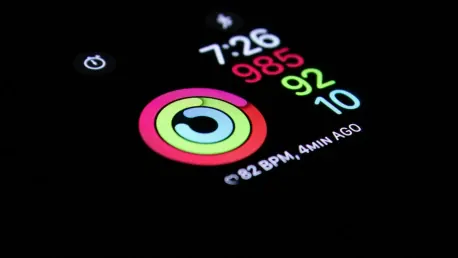Apple has been steadily transforming its array of technology devices into essential health tools. This notable evolution includes the addition of heart rate tracking, ECG functionality, blood oxygen monitoring, and sleep tracking across the Apple Watch and iPhone, which integrates seamlessly with the Health app. Apple’s potential introduction of blood pressure monitors signifies a promising development aimed at giving users a more comprehensive view of their cardiovascular health, which is pivotal to understanding heart disease prevention and overall wellness.
The Importance of Blood Pressure Monitoring
Hypertension: The Silent Killer
Blood pressure monitoring serves as a significant healthcare tool because hypertension often goes symptomless, earning the notorious nickname “silent killer.” Hypertension increases the risk of severe conditions such as heart attacks and strokes, making it crucial to keep track of it even when no symptoms are evident. Traditionally, monitoring blood pressure required the manual use of cuffs and monitors, which may not be convenient for daily use, deterring many from frequent self-checks.
By merging blood pressure features into Apple Health, Apple aims to simplify this process through wearable technology, making regular monitoring more accessible for everyone. Wearable technology can provide continuous data, making it easier to detect early signs of hypertension and manage it effectively, potentially transforming how people view and handle their cardiovascular health. The convenience of having blood pressure monitoring on a device like the Apple Watch could lead to significant improvements in public health outcomes by encouraging more people to keep an eye on this critical health metric.
Potential Impact on Cardiovascular Health
Although Apple has not officially confirmed the specifics about its blood pressure monitoring technology, various reports and patents suggest several plausible methodologies. These potential methods include wearable sensors and non-invasive techniques, AI-driven health insights, and seamless data integration with Apple Health. The goal of these technologies is to provide users with a more convenient and comprehensive way to monitor their cardiovascular health, revolutionizing how people stay informed about their blood pressure levels.
Wearable sensors may detect blood flow changes or measure vascular tension non-invasively, making it easier for people to monitor their blood pressure without traditional cuffs. Meanwhile, AI-driven health insights could offer personalized alerts and recommendations based on historical data trends, potentially identifying hypertension risks before they develop into serious health issues. Finally, integrating this data with Apple Health would allow users to access detailed reports and share vital information with healthcare providers, enhancing the overall utility of the Apple Health ecosystem.
Technological Innovations in Blood Pressure Monitoring
Wearable Sensors and Non-Invasive Techniques
One of the most exciting aspects of Apple’s potential blood pressure monitoring technology lies in the development of wearable sensors capable of measuring blood pressure non-invasively. Such sensors could be incorporated into the Apple Watch, leveraging optical sensors to detect blood flow changes or pressure sensors for wrist-based vascular tension readings. This approach would eliminate the need for traditional cuffs, offering a more user-friendly and convenient method for tracking blood pressure on a regular basis.
The integration of these advanced sensors would mark a significant advancement in wearable health technology, aligning with Apple’s mission to provide powerful health tools that integrate seamlessly into everyday life. These innovations could make it easier for users to monitor their blood pressure consistently, contributing to better overall health management and prevention of cardiovascular diseases. Moreover, the convenience of having such capabilities on a widely-used device like the Apple Watch could lead to higher adoption rates, encouraging more people to stay proactive about their health.
AI-Driven Health Insights
Artificial intelligence (AI) further enhances the potential of blood pressure monitoring by providing personalized insights based on historical data trends. With AI integration, users might receive alerts when their blood pressure deviates from their normal range or if there is a risk of developing hypertension. Such personalized insights allow users to take timely action, whether it involves consulting with a healthcare provider or making lifestyle changes to improve their cardiovascular health.
Machine learning algorithms could analyze large amounts of health data to offer more accurate predictions and personalized recommendations for users. This approach aligns with Apple’s commitment to leveraging advanced technology for health improvement, ensuring that users benefit from the most precise and actionable health information possible. By integrating AI-driven health insights into the Apple Health ecosystem, Apple continues to empower users with tools for better health management and personalized care.
Data Integration with Apple Health
Consistent with other health metrics, blood pressure data would be securely stored in the Apple Health app, allowing users to access detailed reports, set health goals, and share data with healthcare providers directly from their devices. This seamless integration enhances the user experience by providing a one-stop platform for health monitoring and management. Users can track their progress, receive feedback, and make informed decisions about their health, all within the familiar interface of Apple Health.
By aligning blood pressure monitoring with the existing suite of health features, Apple reinforces its ethos of empowering users with continuous monitoring and data-driven insights. This comprehensive approach not only helps users maintain better control over their cardiovascular health but also facilitates more informed discussions with healthcare providers. Having easy access to organized and detailed health data can significantly improve the quality of care and enable proactive health management.
Challenges in Developing Blood Pressure Monitoring Technology
Accuracy and Calibration
Achieving accuracy in blood pressure monitoring without an inflatable cuff, which directly applies pressure to the artery, is particularly challenging. To provide precise measurements, Apple must develop advanced algorithms and calibration techniques that ensure the accuracy of wearable-based readings. This process will likely require extensive testing and validation to meet the high standards expected of a medical-grade device. Ensuring that these measurements are consistent and reliable is paramount for user trust and adoption.
Moreover, obtaining regulatory approval from bodies such as the FDA is a critical step in bringing this technology to market. Apple has a proven track record in navigating these regulatory landscapes, as demonstrated by its FDA-cleared features like ECG and irregular heart rhythm notifications. However, achieving the same level of regulatory compliance for blood pressure monitoring presents a unique set of challenges that the company must overcome to realize its vision.
Regulatory Compliance
Health features on Apple devices are subject to stringent regulatory oversight to ensure safety and accuracy. Blood pressure monitoring technology must meet rigorous standards to gain approval from regulatory bodies like the FDA. Apple has experience navigating these requirements, as evidenced by the successful clearance of their ECG and irregular heart rhythm notifications. Ensuring compliance with these regulations will be crucial for the successful rollout of blood pressure monitoring technology, as it assures users of the feature’s reliability and safety.
The approval process involves extensive testing and validation to demonstrate that the technology meets strict criteria for medical devices. Apple must ensure that its blood pressure monitoring feature is both effective and safe for widespread use, which involves submitting detailed evidence to regulatory bodies. This process can be time-consuming but is essential for maintaining the high standards expected of a health tool integrated into Apple’s ecosystem. Regulatory compliance not only instills confidence in users but also solidifies Apple’s commitment to offering reliable and accurate health features.
User Experience and Adoption
Balancing accuracy and ease of use is crucial for the success of Apple’s blood pressure monitoring feature. Users might become frustrated if the feature requires frequent calibration or if it provides inconsistent readings. Apple’s focus on intuitive design and seamless integration will be vital in encouraging widespread adoption. Ensuring that the feature is user-friendly and reliable will help alleviate any potential frustrations, making it a valuable addition to users’ health management routines.
To encourage large-scale adoption, Apple must ensure that the user experience is as seamless and hassle-free as possible. This involves making the feature easy to access, simple to use, and integrating it seamlessly with the existing Apple Health app. Addressing these aspects will be key to the feature’s success, as users are more likely to adopt and consistently use health tools that are convenient and reliable. Apple’s emphasis on intuitive design and user experience positions it well to overcome these challenges and deliver a valuable health monitoring tool.
Benefits of Apple Health Blood Pressure Monitors
Early Detection and Prevention
One of the primary benefits of integrating blood pressure monitoring into Apple Health is the ability to detect abnormal blood pressure trends early. Regular monitoring enables users to identify potential issues before they develop into serious conditions, allowing for timely interventions such as dietary adjustments, increased physical activity, or consultations with healthcare providers. This proactive approach to health management can significantly impact users’ long-term health outcomes, reducing the risk of severe cardiovascular events.
Early detection through continuous monitoring allows users to take control of their health and make informed decisions that can prevent the onset of hypertension and other related conditions. The convenience of having this capability on a wearable device like the Apple Watch encourages more frequent monitoring, which is essential for early detection and prevention. By making blood pressure monitoring more accessible and user-friendly, Apple Health could play a pivotal role in improving public health and reducing the burden of cardiovascular diseases.
Improved Health Management
For individuals already diagnosed with hypertension, continuous tracking of blood pressure can provide valuable feedback on the effectiveness of lifestyle changes or medications. By monitoring their blood pressure regularly, users can assess how well their current treatment plans are working and make necessary adjustments in consultation with their healthcare providers. This continuous feedback loop enables more personalized and effective health management, helping individuals better manage their condition and improve overall health outcomes.
The integration of blood pressure monitoring into Apple Health also allows users to track their progress over time, set health goals, and receive personalized recommendations. By analyzing diverse health metrics—such as heart rate, sleep patterns, and physical activity—Apple Health can offer comprehensive insights into cardiovascular health. These personalized health recommendations align with Apple’s commitment to long-term wellness, empowering users to take proactive steps in managing their health and achieving their wellness goals.
Personalized Health Recommendations
By analyzing a range of health metrics, including heart rate, sleep patterns, and physical activity, Apple Health could provide personalized recommendations for improving cardiovascular health. These insights can help users make informed decisions about their lifestyle, such as dietary adjustments or changes in physical activity levels, tailored to their unique health profiles. Personalized health recommendations enhance the utility of the Apple Health app, making it a more integral part of users’ daily health routines.
These personalized insights can empower users to take control of their health, enabling them to make proactive decisions that positively impact their well-being. Apple’s commitment to leveraging advanced technology for health improvement ensures that these recommendations are based on accurate and comprehensive data, providing users with the confidence they need to make effective changes. As users increasingly prioritize health and wellness, the ability to receive tailored advice and support through Apple Health is set to become an invaluable tool for maintaining and improving overall health.
Apple’s Broader Strategy in Healthcare
Partnerships with Healthcare Providers
Apple’s collaborations with recognized institutions like Stanford Medicine and Mayo Clinic enable evidence-based practice enhancements in their health features. These partnerships ensure that the health data collected through Apple’s devices provide reliable and clinically relevant information to users and their healthcare providers. By working with leading healthcare institutions, Apple can continuously improve the accuracy and effectiveness of its health monitoring features, further solidifying its position in the healthcare industry.
These collaborations allow Apple to incorporate the latest medical research and insights into its health tools, ensuring that users benefit from the most up-to-date and accurate health information. Additionally, by partnering with healthcare providers, Apple can facilitate better integration between its devices and the healthcare system, enabling more seamless data sharing and improving overall patient care. These partnerships highlight Apple’s commitment to advancing healthcare through technology and providing users with trusted tools for their health management.
Empowering Users with Health Data
Apple’s principle of data privacy enables users to securely store and manage medical information on their devices, ensuring that sensitive health data remains protected. The integration of blood pressure monitoring would extend this capability, giving users greater control over their health data and enabling more informed discussions with healthcare providers. This empowerment aligns with Apple’s vision of user-centric health management, where users have the tools and information necessary to take charge of their health.
By providing users with easy access to their health data, Apple promotes a more engaged and proactive approach to health management. Users can track their progress, set goals, and share important health information with their providers from the convenience of their devices. This empowerment not only enhances the user experience but also supports better health outcomes by encouraging users to take an active role in their health care. Apple’s commitment to data privacy and user empowerment continues to set a standard in the industry, ensuring that users can trust their devices with their most sensitive health information.
Supporting Preventive Care Initiatives
Apple has consistently transformed its technology devices into essential tools for health monitoring. The Apple Watch and iPhone are now equipped with features like heart rate tracking, ECG functions, blood oxygen monitoring, and sleep tracking, all seamlessly integrated with the Health app. This evolution represents a significant shift towards making healthcare more accessible and everyday health tracking quite comprehensive. The potential addition of blood pressure monitors to Apple’s lineup is an exciting development, aimed at providing users with an even more detailed overview of their cardiovascular health. This could play a crucial role in heart disease prevention and overall wellness, offering users the tools they need to monitor their health more effectively. Apple’s innovations in health technology not only enhance user experience but also contribute to a broader understanding of personal health metrics, empowering users to take proactive steps in managing their health. The integration of such features into widely used devices could help revolutionize how people approach health and wellness on a daily basis.









